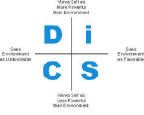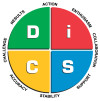A Short Introduction to the DiSC Model of Behavior
Four Categories
Throughout history people have attempted to explain the differences among people. The earliest recorded efforts were rather crude. With more recent advances in research and our expanded knowledge of psychology, a number of more sophisticated models of human behavior have evolved. Interestingly enough, many of these models have one characteristic in common: the grouping of behavior into four categories.
Hippocrates
The earliest credible model dates back to Greek and Roman times. Hippocrates was the most notable of these historical figures to utilize this four-factor model. However the concept was also mentioned by Aristotle and others in the Greek era and, most notably, by Galen in the Roman era. These notable individuals believed that the differences in behavior were caused by variations in the relative quantities of our bodily fluids. They referred to the four temperaments as Choleric (yellow bile), Sanguine (blood), Phlegmatic (phlegm) and Melancholic (black bile). This terminology is still used by some writers today, especially by religious educators. There is also evidence of an awareness of four types of behavior in ancient Hebrew writings.
More Recent Times
In more recent times such respected scholars as Immanual Kant, Hans Eysenck and William James wrote about similar four-factor models of human behavior. Perhaps the best known of such modern scholars was Carl Jung. Jung’s classic book, Psychological Types, written in 1923 was the first sophisticated, scientific account of this theory. The popularity, which Jung enjoyed, led to and increased interest in the topic of personality types. His work, which describes the Sensor, Feeler, Thinker and Intuitor, forms the basis for the Myers-Briggs Type Indicator and other works dealing with temperament and personality types.
Today, there are many types of assessments that measure many different characterestics. Here are a few examples:
- Insights (Color assessment)
- Listening Styles
- Team Dimensions
- Bird Personality Quiz (you read that correctly!)
William Moulton Marston – The Beginning of D. I. S. C.
The book, Emotions of Normal People, published by William Moulton Marston in the 1920’s forms the theoretical basis for the DiSC® Model of Behavior, the resulting DiSC® Classic Profile, and the newest circumplex presentation. Unlike Jung, Marston was not concerned with categorizing people into psychological types; rather he focussed on categorizing behavior into four types. He theorized that effective people would behave in a manner consistent with the demands and expectations of the environment.
for the DiSC® Model of Behavior, the resulting DiSC® Classic Profile, and the newest circumplex presentation. Unlike Jung, Marston was not concerned with categorizing people into psychological types; rather he focussed on categorizing behavior into four types. He theorized that effective people would behave in a manner consistent with the demands and expectations of the environment.
This implies that a person’s behavior will vary from one situation to another even though each person may have a core behavior that is most natural and comfortable for that person. On the basis of Marston’s original research, Dr. John Geier developed an instrument called the Personal Profile System in the 1960s. He conducted further research to refine Marston’s model and to determine the unique Classical Profile Patterns which are based upon combinations of the various behavioral styles.
DiSC® Today – a plan to understand self and others
Behavioral Patterns
All of us have developed behavioral patterns: distinct ways of thinking, feeling, and acting. The central core of our patterns tends to remain stable because it reflects our individual identities. However, the demands of the work environment often require different responses that evolve into a work behavioral style.
The DiSC Profile
 The DiSC Profile presents a plan to help you understand yourself and others in a specific environment. You are the central focus as you heighten understanding of your style and identify the environment most conducive to your success. At the same time, you learn about the differences of others and the environment they require for maximum productivity and harmony in the work organization.
The DiSC Profile presents a plan to help you understand yourself and others in a specific environment. You are the central focus as you heighten understanding of your style and identify the environment most conducive to your success. At the same time, you learn about the differences of others and the environment they require for maximum productivity and harmony in the work organization.
Four dimensions of behavior, thousands of unique patterns
The DiSC® model identifies four dimensions of normal behavior:
- Dominance: People with a “D” personality type seek to shape their environment by overcoming opposition to accomplish results.
- influence: People with an “i” personality type seek to shape their environment by influencing or persuading others.
- Steadiness: People with an “S” personality type seek to cooperate with others to carry out their tasks.
- Conscientiousness: People with a “C” personality type seek to work within existing circumstances to ensure quality and accuracy.
There are 2041 possible combinations of these four dimensions of behavior when plotted on the 7-segment DiSC® Classic graph. Human behavior is complex and we are each unique. But an understanding of each of the four dimensions and the intensity each plays out in our personal style can go a long way toward building successful relationships at work and at home. The latest circumplex presentation of DiSC uses 8 scales and plots a dot on a circular map. And, with Adaptive Testing, this third generation of DiSC is 32% more accurate than DiSC Classic.
Toward a more successful work style
A DiSC assessment is not a test. You cannot pass or fail. There isn’t a best pattern. Research evidence supports the conclusion that the most effective people are those who know themselves, know the demands of the situation, and adapt strategies to meet those needs. In summary, DiSC enables you to:
- Identify your work behavioral style
- Create the motivational environment most conducive to success
- Increase your appreciation of different work styles
- Identify and minimize potential conflicts with others
- ….. and more!
To Learn More:
- Review the newest DiSC application kits
- Listen to interview with Arnie Warren, Author of the Great Connection
- Listen to interview with Julie Straw, Author of 4 Dimensional Manager
- Become a certified DISC Facilitator
- Test DiSC with our trial offer risk free
Watch Dr. Mark Scullard, Wiley VP Research, discuss the history of DiSC.
DiSC® with a small i is a registered trademark of Wiley Workforce Solutions (formerly Inscape Publishing). There are many DISC products on the market today but the Wiley products are the most highly validated and reliable you can buy and The TEAM Approach provides the most in-depth and cost effective training available today.








